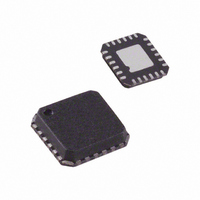ADF4360-4BCPZ Analog Devices Inc, ADF4360-4BCPZ Datasheet - Page 21

ADF4360-4BCPZ
Manufacturer Part Number
ADF4360-4BCPZ
Description
IC INT SYNTH/VCO SEALED 24-LFCSP
Manufacturer
Analog Devices Inc
Type
Fanout Distribution, Integer N Synthesizer (RF)r
Datasheet
1.ADF4360-4BCPZ.pdf
(24 pages)
Specifications of ADF4360-4BCPZ
Pll
Yes
Input
CMOS
Output
Clock
Number Of Circuits
1
Ratio - Input:output
1:2
Differential - Input:output
No/No
Frequency - Max
1.75GHz
Divider/multiplier
Yes/No
Voltage - Supply
3 V ~ 3.6 V
Operating Temperature
-40°C ~ 85°C
Mounting Type
Surface Mount
Package / Case
24-LFCSP
Frequency-max
1.75GHz
Pll Type
Frequency Synthesis
Frequency
1.45GHz
Supply Current
10mA
Supply Voltage Range
3V To 3.6V
Digital Ic Case Style
LFCSP
No. Of Pins
24
Operating Temperature Range
0°C To +150°C
Lead Free Status / RoHS Status
Lead free / RoHS Compliant
For Use With
EVAL-ADF4360-4EBZ1 - BOARD EVALUATION FOR ADF4360-4
Lead Free Status / RoHS Status
Lead free / RoHS Compliant, Lead free / RoHS Compliant
Available stocks
Company
Part Number
Manufacturer
Quantity
Price
Part Number:
ADF4360-4BCPZ
Manufacturer:
ADI/亚德诺
Quantity:
20 000
Company:
Part Number:
ADF4360-4BCPZRL7
Manufacturer:
ELPIDA
Quantity:
147
Part Number:
ADF4360-4BCPZRL7
Manufacturer:
ADI/亚德诺
Quantity:
20 000
FIXED FREQUENCY LO
Figure 18 shows the ADF4360-4 used as a fixed frequency LO at
1.6 GHz. The low-pass filter was designed using ADIsimPLL for
a channel spacing of 8 MHz and an open-loop bandwidth of
40 kHz. The maximum PFD frequency of the ADF4360-4 is
8 MHz. Because using a larger PFD frequency allows users to
use a smaller N, the in-band phase noise is reduced to as low as
possible, –100 dBc/Hz. The 40 kHz bandwidth is chosen to be
just greater than the point at which the open-loop phase noise
of the VCO is –100 dBc/Hz, thus giving the best possible inte-
grated noise. The typical rms phase noise (100 Hz to 100 kHz)
of the LO in this configuration is 0.3°. The reference frequency
is from a 16 MHz TCXO from Fox; thus, an R value of 2 is pro-
grammed. Taking into account the high PFD frequency and its
effect on the band select logic, the band select clock divider is
enabled. In this case, a value of 8 is chosen. A very simple pull-
up resistor and dc blocking capacitor complete the RF output
stage.
INTERFACING
The ADF4360 family has a simple SPI®-compatible serial inter-
face for writing to the device. CLK, DATA, and LE control the
data transfer. When LE goes high, the 24 bits that have been
clocked into the appropriate register on each rising edge of CLK
are transferred to the appropriate latch. See Figure 2 for the
timing diagram and Table 5 for the latch truth table.
The maximum allowable serial clock rate is 20 MHz. This
means that the maximum update rate possible is 833 kHz or
one update every 1.2 µs. This is certainly more than adequate
for systems that have typical lock times in hundreds of micro-
seconds.
801BE-160
16MHz
FOX
1nF
10µF
1nF
4.7kΩ
1nF
51Ω
14
16
17
18
19
12
13
CPGND
C
REF
CLK
DATA
LE
C
R
1
V
V
N
C
SET
VCO
VCO
6
Figure 18. Fixed Frequency LO
IN
3
DV
8
21
DD
AGND
9
ADF4360-4
AV
V
VDD
2
10
DD
11
CE MUXOUT
23
22
DETECT
LOCK
DGND RF
15
20
RF
V
OUT
OUT
TUNE
CP
A
B
24
7
4
5
V
4.7nF
VCO
51Ω
430Ω
22.0nF
51Ω
100pF
100pF
Rev. A | Page 21 of 24
ADuC812 Interface
Figure 19 shows the interface between the ADF4360 family and
the ADuC812 MicroConverter®. Because the ADuC812 is based
on an 8051 core, this interface can be used with any 8051-based
microcontroller. The MicroConverter is set up for SPI master
mode with CPHA = 0. To initiate the operation, the I/O port
driving LE is brought low. Each latch of the ADF4360 family
needs a 24-bit word, which is accomplished by writing three
8-bit bytes from the MicroConverter to the device. When the
third byte is written, the LE input should be brought high to
complete the transfer.
I/O port lines on the ADuC812 are also used to control power-
down (CE input) and detect lock (MUXOUT configured as lock
detect and polled by the port input). When operating in the
described mode, the maximum SCLOCK rate of the ADuC812
is 4 MHz. This means that the maximum rate at which the out-
put frequency can be changed is 166 kHz.
ADSP-21xx Interface
Figure 20 shows the interface between the ADF4360 family and
the ADSP-21xx digital signal processor. The ADF4360 family
needs a 24-bit serial word for each latch write. The easiest way
to accomplish this using the ADSP-21xx family is to use the
autobuffered transmit mode of operation with alternate fram-
ing. This provides a means for transmitting an entire block of
serial data before an interrupt is generated.
Set up the word length for 8 bits and use three memory loca-
tions for each 24-bit word. To program each 24-bit latch, store
the 8-bit bytes, enable the autobuffered mode, and write to the
transmit register of the DSP. This last operation initiates the
autobuffer transfer.
ADSP-21xx
ADuC812
I/O PORTS
I/O PORTS
SCLOCK
Figure 20. ADSP-21xx to ADF4360-x Interface
SCLOCK
Figure 19. ADuC812 to ADF4360-x Interface
MOSI
MOSI
TFS
SCLK
SDATA
CE
MUXOUT
(LOCK DETECT)
SCLK
SDATA
CE
MUXOUT
(LOCK DETECT)
LE
LE
ADF4360-x
ADF4360-x
ADF4360-4






